
views
Preparing for the Test

Sit practise tests to budget your time. If the test is one hour long and has thirty questions, you know that you'll need to have reached at least question number 15 by the halfway mark to remain on track. When you sit your practise tests, recreate the test conditions as closely as possible - with closed books and no music or distractions. If you have difficulty with the practise tests, speak to your instructor and seek out tips to get you back on the right track. Exploit your instructor's knowledge and experience. They have years of experience in seeing people pass and fail. Ask them for their tips – they have the experience so use it to your advantage! Multiple-choice tests often provide two similar answers, so focus on key concepts in your studying. Knowing how to study for tests will target your studying and make it more efficient. Budget your time to make sure you have allowed enough time at the end of the test to review your answers and ensure that you enter them correctly onto the answer sheet.

Decide your strategy for unknown answers. Is it better to leave an answer blank or to make a random guess? The answer will differ in each case, as it depends on the specific policy of each multiple choice test. In some tests you can gain a point for a random guess (assuming that you get it right), but in others a point (or fraction of a point) is deducted for each wrong answer, so guessing is a bad idea that can lose you serious points. Thinking in advance will save you time when it counts in the exam. Ask your instructor or the test setting body what the scoring policy is. Make the best decision for your particular test and remind yourself of your strategy before you go in. In tests where you lose only a fraction of a point for a wrong answer but earn a full point for a correct answer, such as the SAT, you may benefit from taking a guess -- especially if you can eliminate obviously wrong answers.

Adopt an anxiety management plan. Know what tactics will increase your confidence, and which triggers will knock it. This knowledge will let you seek out and use the best relaxation methods that work for you. Learning how to manage it is the best tactic to succeed under test conditions. Use online resources to help you identify, manage and reduce your stress levels to deal with your exam stress and reduce stress through exercise. Exam anxiety happens to everyone, but giving in will simply hand you two problems to deal with instead of one.
Strategically Answering Questions

Read the questions carefully. Once the clock is ticking you might be tempted to race to the answers, but time spent correctly interpreting the questions is critical. This is what will truly save you time when it comes to picking the correct answers. Questions give away a lot of information, so read them closely. Always try to think of the correct answer before you look at the multiple answers provided. Cover the answers while you read the question so that you can think without being distracted. Read all the possible answers. B may be true but remember that it might be in a list of answers in which all are true - making D “all of the above” the correct answer.

Skip difficult questions to return to them later. If you cannot answer a question within the time limit which you calculated, move and on and plan to return to it later. Mark any questions you didn't answer with a clear, bold mark to make sure you see them on your second pass through the test. Remain alert as you work through the paper for hints that might help you to answer the questions that you are unsure of. Set aside some time at the end of the test to return to the answers that you were unsure of. Make sure to skip the question spot on your answer sheet as well, especially if you are using a scantron. You don't want to end up with a bunch of answers wrong because you filled in the bubbles incorrectly.

Hunt for word clues. Note or circle the most important words in the question. The specific words used can be incredibly useful tools in finding the right answer. Look for these details in each multiple choice answer. The correct answer must match every part of the question, so pay attention to negatives (“none,” “not,” “neither”), superlatives (“most,” “best”), and qualifiers (“usually,” “often,” “generally” “may.”) Watch out for negatively worded questions, as they can confuse you into picking the wrong answer. Options that use the words "not," "none" or "never” can turn a true statement into a false one.
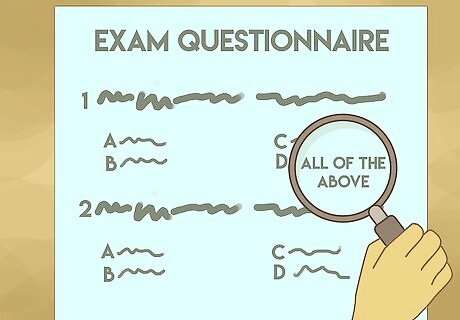
Avoid extremes. Be wary of questions containing absolutes (“always,” “never,” “every.”) For them to be true there must be no room for alternatives. Watch out for "none of the above", or "all of the above.” If you know that more than one of the answers are correct or incorrect, then the correct answer has to be one of these answers. If one of the options seems completely out of place, then it’s probably because it doesn’t belong there.
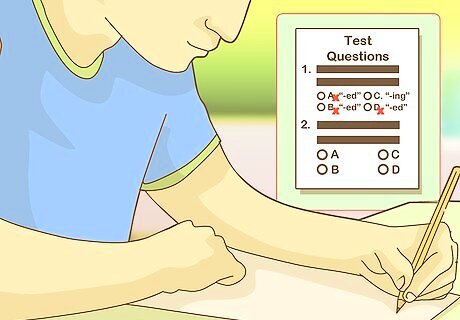
Look out for answers that don’t match the grammar of the question. Cross off any answer that does not match. Correct answers can sometimes be found by looking at the tense of the word, and comparing it to the endings of the various possible answers. If the question indicates that the answer should end in "-ing" but only one of the answer choices does and the rest of the choices end in "-ed" this may be the correct answer. If the question ends with "a" or "an," then the first word of the correct answer will most likely match that given article.

Apply the process of elimination. Strike out obviously false answers. This means using logic to rule out answers that don’t make sense, or don’t fully answer the question. Working from two or even three options instead of four will seriously improve your chances. Treat each answer as a true or false question. Cross out any options that are not true. For instance if you know it is definitely not ‘D’ cross it out. Look for pairs - either two answers that are opposites or two that are identical apart from one word. This is a common tactic of test-setters to separate those who really know the topic from those with a surface understanding of it. In such pairs, one of these may well be the correct answer as the other is worded to distract you from it.
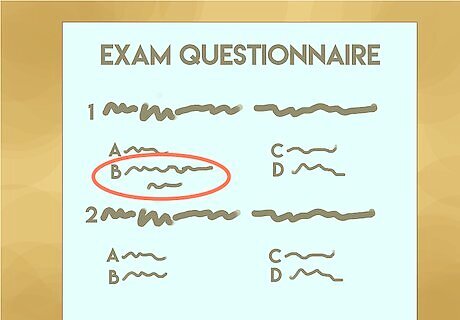
Consider more risky tactics. There are many urban myths about tricks to pass multiple choice tests, but if you must gamble it is wiser to take advice from studies which have looked at the statistical probability of patterns in multiple choice tests. Try choosing the longest answer. It may be more likely to be the correct one because the instructor may have added qualifiers. Ignore the rule that you should never change your first choice. Use your reasoning skills on a case-by-case basis to decide if you should change an answer.
Reviewing the Test

Review the skipped questions. Now that you have implemented your tactics for answering as many questions as possible it is time to use your pre-planned strategy. You have read all the information provided and now you can bring this knowledge to use in the time slot that you allotted to review the questions with fresh eyes. Think back over the other questions - you may have picked up hints or had your memory jogged by working through the other answers. Implement your strategy on whether to guess or leave blanks.

Check your work. Be very careful about how you fill out the answer sheet. Entering an answer in the wrong space can have a domino effect; that is, not only is that answer incorrect but every subsequent answer will be incorrect. To avoid this be sure to transfer all your answers to the answer sheet at the same time after completing all the questions. Be sure that you have filled the appropriate answer spaces. If you are leaving an answer blank, be sure that the next answer you enter is in the correct space.
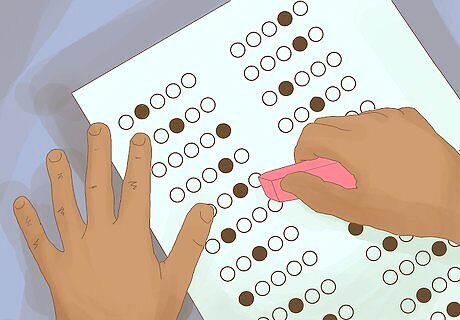
Erase any accidental marks. Make sure you remove any stray marks or notes which could confuse the person who will be marking your test. If you are using a scantron sheet, make sure your answer bubbles are thoroughly darkened and any erasures are fully erased.



















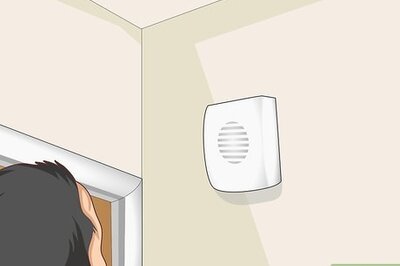
Comments
0 comment